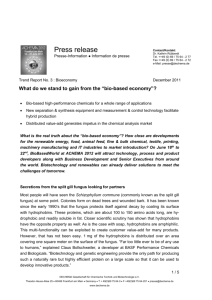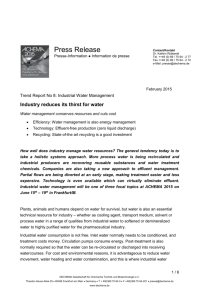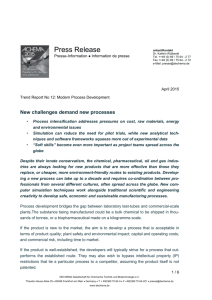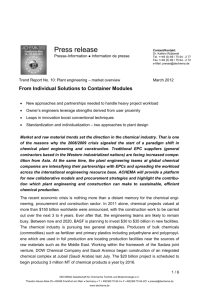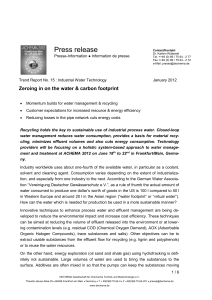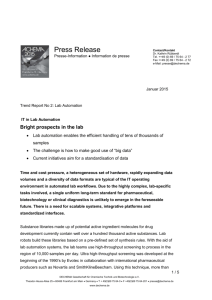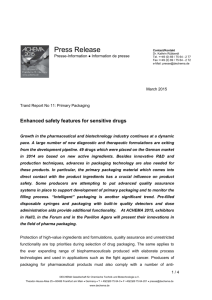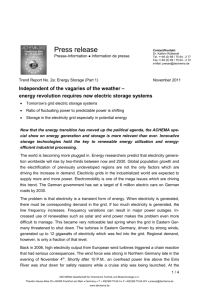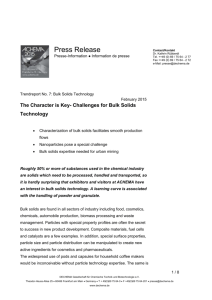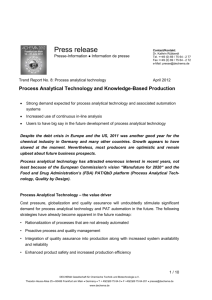doc
advertisement
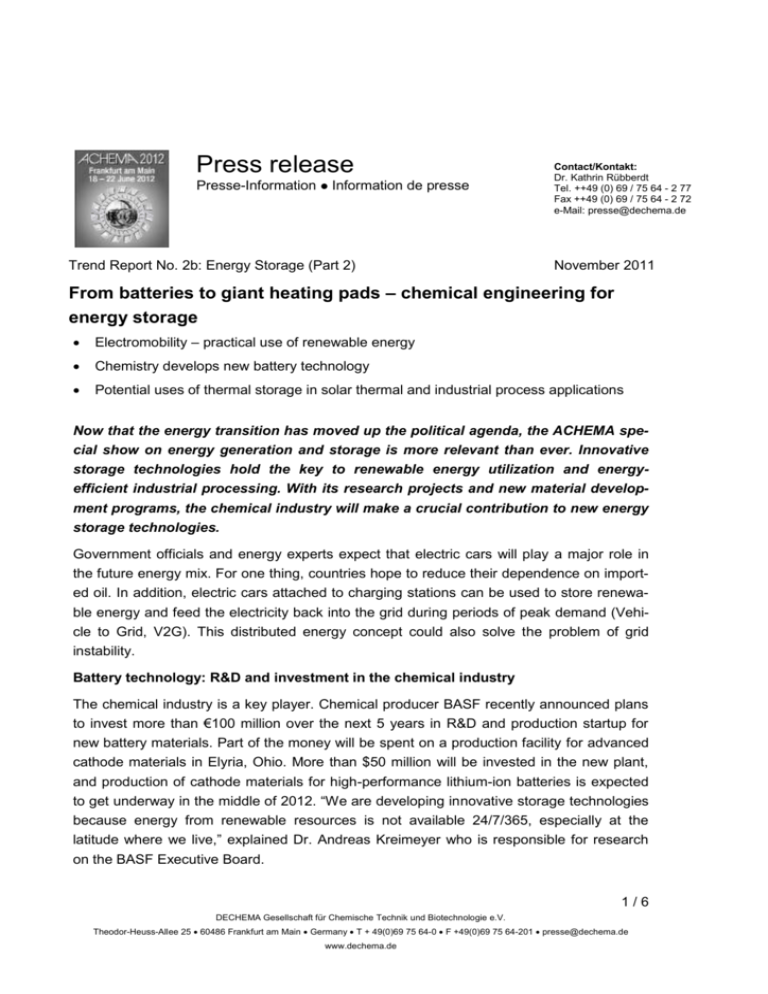
Press release Presse-Information Information de presse Trend Report No. 2b: Energy Storage (Part 2) Contact/Kontakt: Dr. Kathrin Rübberdt Tel. ++49 (0) 69 / 75 64 - 2 77 Fax ++49 (0) 69 / 75 64 - 2 72 e-Mail: presse@dechema.de November 2011 From batteries to giant heating pads – chemical engineering for energy storage Electromobility – practical use of renewable energy Chemistry develops new battery technology Potential uses of thermal storage in solar thermal and industrial process applications Now that the energy transition has moved up the political agenda, the ACHEMA special show on energy generation and storage is more relevant than ever. Innovative storage technologies hold the key to renewable energy utilization and energyefficient industrial processing. With its research projects and new material development programs, the chemical industry will make a crucial contribution to new energy storage technologies. Government officials and energy experts expect that electric cars will play a major role in the future energy mix. For one thing, countries hope to reduce their dependence on imported oil. In addition, electric cars attached to charging stations can be used to store renewable energy and feed the electricity back into the grid during periods of peak demand (Vehicle to Grid, V2G). This distributed energy concept could also solve the problem of grid instability. Battery technology: R&D and investment in the chemical industry The chemical industry is a key player. Chemical producer BASF recently announced plans to invest more than €100 million over the next 5 years in R&D and production startup for new battery materials. Part of the money will be spent on a production facility for advanced cathode materials in Elyria, Ohio. More than $50 million will be invested in the new plant, and production of cathode materials for high-performance lithium-ion batteries is expected to get underway in the middle of 2012. “We are developing innovative storage technologies because energy from renewable resources is not available 24/7/365, especially at the latitude where we live,” explained Dr. Andreas Kreimeyer who is responsible for research on the BASF Executive Board. 1/6 DECHEMA Gesellschaft für Chemische Technik und Biotechnologie e.V. Theodor-Heuss-Allee 25 60486 Frankfurt am Main Germany T + 49(0)69 75 64-0 F +49(0)69 75 64-201 presse@dechema.de www.dechema.de Evonik, a BASF competitor, is also working on battery systems. The company has joined forces with other partners to build the world's largest lithium-ceramic battery. By using a special combination of ceramics and high molecular weight ion conductors, the consortium is attempting to increase energy density and maximize cycle life. The electric storage unit is being built at a power station in the Saar region, and it will have a storage capacity of around 700 kWh. If this storage unit were to charge and discharge every fifteen minutes, it could theoretically supply enough electricity for 4000 households. Plans are already in place to increase the capacity to 10 MW. “We are leveraging our lithium-ion expertise to penetrate a completely new market,” said Dr. Klaus Engel, Executive Board Chairman at Evonik. “For the first time, lithium-ceramic technology will enable us to separate generation and consumption at a viable cost. We will be able to stabilize fluctuations in the grid caused by solar and wind generation, and that will increase overall efficiency. As is the case in the vehicle sector, this market will be worth billions,” claimed Engel. Experts predict that the market for state-of-the-art energy storage systems will eventually exceed €10 billion. In Germany alone, demand for state-of-the-art storage systems will be in the upper 3-digit MW range. The goal of the 3-year LIB 2015 research initiative, which is receiving funding from the Federal Ministry of Education and Research (BMBF), is to develop mega batteries for stationary applications. Under the umbrella of the LIB 2015 Lithium Ion Battery Innovation Alliance, an industry consortium consisting of BASF, Bosch, Evonik, LiTec and VW has allocated €360 million to lithium-ion battery research and development. BMBF will be providing €60 million of funding for this field of research. Scalable electrochemical energy storage systems in the 100 kW to 5 MW range will be needed to store large amounts of energy. This is an area where redox flow batteries appear to have very significant potential. With this type of battery, electricity is stored as chemical energy in redox pairs which are held in external tanks. Electricity is generated in a separate reactor while electrolyte is continuously circulated to the electrodes from the storage tanks. The direction of the electrolyte flow is reversed for charging. Tank size provides storage scalability, and efficiency can be as high as 80 %. At the Fraunhofer ICT institute in Pfinztal, a prototype redox flow battery has been developed to test various electrode materials, membranes and electrolytes. The long-term goal is to build a 20 MWh battery system which is capable of supplying electricity to around 2000 households when renewable energy is unavailable. There are a number of other battery technologies besides the ones described above. Some are already operational (e.g. sodium sulfide batteries), but most are still at the research stage. Energy density is a major factor to consider when assessing the future energy potential. The energy density of NaS batteries is 150 kWh/m3 compared to 70 kWh/m3 for lead batteries. Li-ion batteries have even higher energy density (350 kWh/m3). 2/6 DECHEMA Gesellschaft für Chemische Technik und Biotechnologie e.V. Theodor-Heuss-Allee 25 60486 Frankfurt am Main Germany T + 49(0)69 75 64-0 F +49(0)69 75 64-201 presse@dechema.de www.dechema.de Hydrogen storage – high energy density, big challenges ahead Hydrogen storage provides even higher energy density than batteries. The basic idea is to use excess electricity to electrolytically decompose water. The hydrogen is then stored in underground caverns. As much as 350 kWh per cubic meter can be stored at pressures up to 350 bar, a factor of more than 100 compared to compressed air storage. The first challenge is to improve electrolysis techniques (efficiency roughly 75 %). Moreover, to generate electricity with the stored hydrogen, advances in power station technology (steam turbine efficiency approximately 60 %) will be necessary, and that is anything but trivial. Nevertheless, hydrogen storage offers very significant potential. Hydrogen is not only a source of stored energy, but it is also used to synthesize a large number of chemicals including methane and methanol as well as many basic and special chemicals. Hydrogen is used in fuel cells and hydrogen-powered vehicles. Up to this point, natural gas has been the principle source of hydrogen in the chemical industry. Hydrogen produced with ecofriendly electricity could be a viable CO2-free option. Siemens, among others, is looking for ways of optimizing water electrolysis for commercial applications. New membrane materials and current collectors made of porous sintered metal at the electrodes ensure that changes in the current supply are anticipated within milliseconds and the nominal output and operating pressure can increase. Plans are in place to build a 300 kW demonstration container based on Proton Exchange Membrane technology by 2012. The results will also provide an input to the CO2RRECT project (CO2-Reaction using Regenerative Energies and Catalytic Technologies), a joint research undertaking involving the academic community and Bayer, RWE and Siemens, which is looking at ways of utilizing carbon dioxide as a resource with the aid of renewable energy. Thermal storage – indispensable for solar thermal and industrial applications Thermal storage will be another key technology in the future. Heating accounts for roughly half of European energy consumption. Besides the need to keep buildings warm, industrial processing is the other major factor in heat consumption. To increase the efficiency of compressed air storage (discussed above), it is necessary to store the heat which is generated during the compression process, so that the heat can be used later during electricity generation. Thermal storage is also vital at solar thermal power stations which use concave mirrors to concentrate solar heat and generate steam for the turbines. With the stored heat, electricity can be generated even in the absence of sunlight (e.g. at night). Once again, the economic aspects are critical. 24/7 electricity generation is only cost effective and suitable for meeting basic demand if storage costs fall below €10 to €20 /kWh. 3/6 DECHEMA Gesellschaft für Chemische Technik und Biotechnologie e.V. Theodor-Heuss-Allee 25 60486 Frankfurt am Main Germany T + 49(0)69 75 64-0 F +49(0)69 75 64-201 presse@dechema.de www.dechema.de Currently there are four basic ways of storing heat: Sensible heat storage Latent heat storage Sorption heat storage Chemical storage There is no single best thermal system for storing electricity. The storage systems have to be carefully selected and matched to the specific application. As it is normally most efficient to generate heat from primary energy, the development of thermal storage systems for industrial applications is largely still in its infancy. Sensible heat storage is currently the most widespread and practicable solution. Space heating in buildings is a good example. On this type of system, the temperature of the heat transfer medium (e.g. water) changes noticeably (i.e. can be observed) when heat is transferred in and out. A technique developed by the German Aerospace Center (DLR) for storing solar radiation energy in low-cost solids is one of the latest developments. A 500 kWh demonstration plant is currently under construction in Stuttgart. The results of testing conducted at 400 °C are expected to be available by 2013. What sets CellFlux storage technology apart is its compatibility with different types of media including heat transfer oil, steam and molten salt, making it suitable for any type of solar thermal power station. The storage system is made up of individual modules (cells) and stores heat in the solid material. Inside the cells, a heat exchanger transfers the heat energy to a stream of air which flows through the solid storage material and transfers heat to it. The process is reversed to extract the heat. In contrast to storage systems in which molten salt must be kept at 230 °C to prevent crystallization, solid storage systems can be operated at lower temperatures. The capital investment costs are also lower. Latent heat storage: high energy density, low temperature differentials In contrast to sensible heat storage systems, the temperature of latent heat storage systems remains essentially constant as they capture or release heat. Everyone knows that ice cubes can be used to keep beverages cool. With enough ice, the temperature inside the glass remains at a constant 0 °C until all of the ice has melted. Latent heat storage systems have a much higher energy density. The amount of energy which melts the ice could heat an equivalent amount of water from 0 °C to 80 °C. Because of this effect coupled with the fact that these systems can be operated at much lower temperature differentials, latent energy storage appears to have great potential in industrial applications. 4/6 DECHEMA Gesellschaft für Chemische Technik und Biotechnologie e.V. Theodor-Heuss-Allee 25 60486 Frankfurt am Main Germany T + 49(0)69 75 64-0 F +49(0)69 75 64-201 presse@dechema.de www.dechema.de Air-conditioning is a good example of latent energy storage. Construction materials for cooling buildings during the day and heating them at night have been developed in recent years. A team at the Fraunhofer Institute for Solar Energy Systems (ISE) and BASF have developed a process for enclosing paraffin wax droplets, which act as Phase Change Material (PCM), inside of hollow spheres made of acrylic glass. The spheres can then be mixed into mortar or plaster. Other substances in addition to paraffin wax such as salt hydrates and salt mixtures (e.g. potassium and sodium nitrate) are also suitable for latent energy storage. Thermal transfer, however, remains the major obstacle standing in the way of this very promising technology. The thermal transfer coefficient depends on the thermal conductivity of the solid storage material, which is normally quite low for organic and inorganic solids. As a result, researchers are attempting to increase thermal conductivity and the thermal exchange surface area. In addition to micro-encapsulation in construction materials (discussed above), development teams working on industrial thermal storage systems are looking at macroencapsulation of salt hydrate in graphite and enlargement of the thermal transfer surface area by designing steel and graphite fins into the latent energy storage systems. Another interesting approach is the use of PCM in heat transfer fluids to greatly increase capacity within a defined and limited temperature range. Sorption energy storage (SES) is based on the following effect: when gas molecules accumulate on certain surfaces (e.g. zeolithes), the heat of evaporation is released, and when the substance evaporates heat is removed from the surrounding environment. Examples include self-cooling beer kegs and the cooling of beverages in earthenware. Equipment complexity has made this technology relatively expensive for industrial use. The primary emphasis of current research is the development of highly efficient sorption materials. Chemical storage has the highest energy density of all thermal energy storage technologies. Heat is applied to a chemical compound to break it down into its constituent parts which are then stored separately. The thermal energy is recovered by allowing the chemical components to react, producing heat (exothermic reverse reaction). Gas-solid reactions are expected to offer the greatest potential due to the high storage densities and long storage duration. The list of possible reactions includes dehydration of salt hydrates or metal hydroxides (e.g. magnesium or copper sulfate hydrate or Mg-, Ca- or Ba(OH)2), decarboxylation of zinc, magnesium or calcium carbonates to metal oxides and deoxygenation of metal oxides (BaO2 or KO2), all of which are endothermic, reversible reactions which take place over a broad temperature range between 100 °C and 1000 °C depending on the reaction. DLR is currently investigating thermochemical heat storage in the Federal Ministry of Economics and Technology’s „CWS“ project. 5/6 DECHEMA Gesellschaft für Chemische Technik und Biotechnologie e.V. Theodor-Heuss-Allee 25 60486 Frankfurt am Main Germany T + 49(0)69 75 64-0 F +49(0)69 75 64-201 presse@dechema.de www.dechema.de Summary: Renewables present a significant challenge for the electric power industry. Storage technologies will have a big role to play. At industrial companies which are able to utilize heat from the production process in CHP systems, thermal energy storage will make a major contribution to increased energy efficiency. The chemical industry holds the key to development of these technologies. A lot of attention will be focused on these issues at ACHEMA 2012 and promising developments will be on display. www.achema.de (The trend reports are compiled by specialized international journalists. DECHEMA is not liable for incomplete or inaccurate information.) 6/6 DECHEMA Gesellschaft für Chemische Technik und Biotechnologie e.V. Theodor-Heuss-Allee 25 60486 Frankfurt am Main Germany T + 49(0)69 75 64-0 F +49(0)69 75 64-201 presse@dechema.de www.dechema.de
